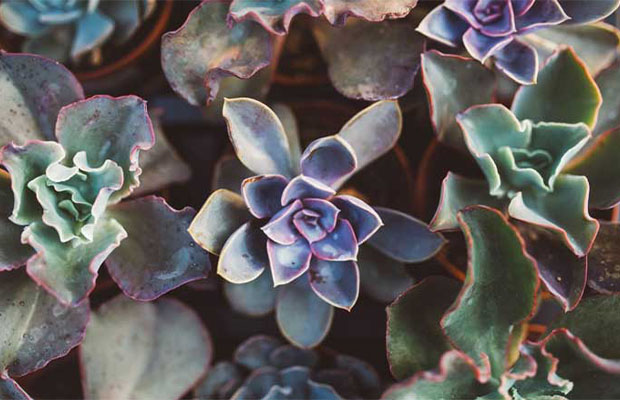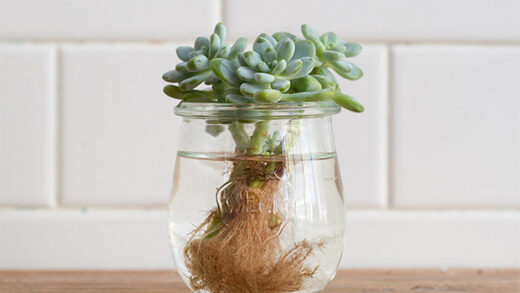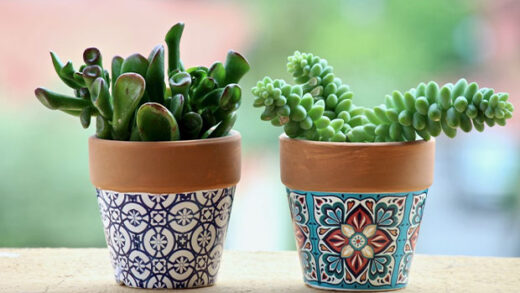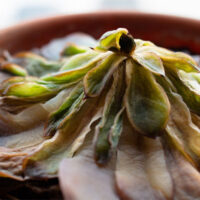Do you adore the way succulents look but have trouble maintaining them? Do you generally have a green thumb?) but succulents just don’t appear to be your thing. You seem to need a little Succulents 101!
Why is my succulent dying? Overwatering and poorly draining soils are the main causes of succulent deaths. Succulents need the soil to dry out in between waterings because they are drought-tolerant plants.
In this article, we’ll discuss 7 reasons why your succulents are dying so you can take them into account, make the necessary adjustments, and enjoy the succulents you’ve always wanted.
Table of Contents
Why is My Succulent Dying?
Succulents fail for a number of reasons, but by making a few adjustments, you can achieve some incredible results. See the 7 causes of succulent death listed below so you can give your succulents the care they require to thrive.
Overwatering Or Underwatering
You are giving them too much water. Unlike ordinary or typical houseplants, succulents don’t require watering. They can survive on less water and prefer well-drained soil because they are a type of cactus. To the touch, the soil should feel cool and damp, but never soggy or watered down, and under no circumstances should it be muddy. Instead of feeding directly, you might want to mist the ground for the best results. A problem might exist if the soil is consistently wet.
Just as succulents can die from overwatering or underwatering, vice versa. To maintain the moisture level at the proper level for your plant, do some research on its water requirements and create a watering schedule.
Related Reading: How Often To Water Succulents?
Space
Did you find a cute teacup or flower pot for your succulent? Sure, it has a nice appearance, but does it allow the roots the space they require to expand? Most likely not, as the width should be at least three times as wide as the plant’s roots and the depth should be twice as deep. This gives the plant lots of space to spread out! Use quality succulent soil, and give your plant room to grow.
Drainage
Succulents are popular plants to grow in cute pots, cups, boots, and other types of containers, but the truth is that without proper drainage, they will never flourish. You should have numerous drainage holes in your container so that water can drain out. You can prevent dirt from escaping and allow extra water to drain by covering the holes with a piece of netting or even pantyhose. Without proper drainage, your succulent’s bottom may experience root rot, dead leaves, and other issues.
Related Reading: Do Succulents Need Drainage?
Warmth
Succulents enjoy warm temperatures. They don’t want to be outside in the cold or close to a drafty window. Place them in a warm place where they can remain warm. If the weather is constantly changing against them, they won’t succeed.
Sunlight
Any plant must receive sufficient light (sun exposure). As they grow through photosynthesis, sunlight serves as their food. If your succulent isn’t getting enough direct sunlight it will begin to stretch and eventually die. If you don’t have a window to put your plant near, you can find plant lights (aka grow lights and lightbulbs) on Amazon.
Related Reading: How Much Light Do Succulents Need?
Pests
When it comes to indoor plants, pests are sometimes the last thing on your mind. However, it is totally possible for your indoor succulents to become infested with fungus gnats, spider mites, mealybugs, and other types of bugs. Neem oil is a natural, safe pesticide that can be used to sparingly spray your plants if you suspect an infestation. Your plant will stay healthy and pests will be less of an issue.
Nutrients
Succulents love nutrient-rich soil. When planting succulents, add some organic material or consider a planting mix. In this manner, they receive the food they require for good health and attractive appearance. Check your local garden center for a soil mix specifically for cactus or succulents, or better yet, make your own succulent soil! These will be the ideal density and nutritional balance for your plants.
Related Reading: What Type of Potting Soil Do Succulents Need?

Can You Revive a Dying Succulent?
The aforementioned technique can help you save a dying succulent, but it might be difficult to save a plant that is on the verge of passing away entirely. In this situation, the only option is to propagate the remaining healthy leaves.
The first step in the procedure is learning how to take plant cuttings. When the soil becomes dry, mist the healthy leaves that have been laid over a well-drained surface. The leaves should have strong roots emerging in a few weeks.
How to Revive a Succulent That is Losing Leaves?
- Scale back how often you water your succulent. Succulents will drop leaves if you water them more frequently than once per week. Always give succulents a good soak and let the soil dry out before giving them another watering. Ideally, succulents should be watered every two weeks. Through the drainage hole in the base, feel the soil in the pot’s bottom. Don’t water right away if the soil feels wet. The ideal time to water is just as the soil is beginning to feel dry.
- Plant your succulent is well draining gritty soil. For the drought-resistant succulent to tolerate, regular potting soil retains too much moisture. Change the soil with special succulent and cacti soil instead (available at garden centers and on Amazon), which is designed to mimic the preferred soil type for succulents with good drainage and a light aerated structure.
- Empty saucers and trays regularly to ensure excess water can drain away from the succulents roots. Because saturated soil fosters the conditions for root rot, which causes succulents to drop their leaves or have their leaves turn yellow, brown, or black, and die back, succulents cannot tolerate being in that situation.
Read More: Succulent Leaves Falling Off
How to Revive Succulents With Wrinkled, Shriveling Leaves?
- Place the succulent in a basin of water for 10 minutes or so. Although succulents don’t require as much watering as other plants, they do grow best when the soil has had a good soak before being allowed to dry out. The drought-stressed succulent can receive much-needed moisture by being submerged in a water basin, which also ensures that the soil is evenly moistened. This is particularly critical if your potting soil’s surface has dried out and now repels water away from the plant’s roots rather than allowing it to permeate. After ten minutes, remove the succulent from the water and let the water drain from the drainage holes.
- Always give your soil a generous soak. In order to ensure that any extra water drips from the pot’s base, succulents should receive a generous soak. This makes sure that the soil is consistently moist, allowing the roots of the succulents to absorb the moisture they need to replenish the moisture reserves in the leaves and reverse their shriveled appearance.
- Increase how often you water succulents (if necessary). Although succulents can withstand drought, they still need regular watering to keep their leaves from becoming wilted or drooping. In order to keep the leaves looking healthy and plump, you should typically give succulents a good soak once every two weeks. To prevent root rot, you should, however, never water plants again before the soil has had a chance to dry out.
- To establish when to your succulent needs watering, feel the soil through the drainage hole in the base of the pot. After watering, check to see how long it takes the soil to dry out by pressing your finger into it. The ideal time to water is when the soil at the base of the pot feels dry. This watering technique mimics the cycle of soil moisture that succulents are used to in their natural environment, which is one of drought, followed by rainfall.
- If water is dripping off the surface of the potting soil, replace it. Peat-based potting soil has a tendency to bake hard when it dries out, which makes water run off the surface. To prevent root rot, succulents require an open, porous soil structure that promotes good drainage and allows water to seep in even when the soil is dried out. Replace your potting soil with specially formulated succulent and cacti soil (available from garden centers or on Amazon) that is designed to mimic the well-draining soil characteristics of the native environment of the succulent.
- Ensure your succulent is not near any sources of indoor heat. The succulent can become too dry and have its leaves become shriveled if it receives too much heat in the evenings from fires, radiators, or forced air. As long as they are not directly in the path of a source of heat, succulents do very well at room temperature of 55°F to 80°F (13°C to 27°C).
How to Revive Succulents With Leaves Dying at the Bottom?
- To revive tall succulents with lower leaves dying, ensure that the succulent is in in a location with enough light. To stay compact and avoid leggy growth, succulents either need bright indirect light (like string, pearl, or snake plants) or 4-6 hours of direct sunlight (like aloe and jade plants).
- Gradually expose your succulent to more light as a sudden contrast from shade to full sun can cause succulents to burn. In order for the succulents to adjust to the brighter levels of light, move them to a sunnier or brighter location for an additional half an hour or so every other day over the course of a few weeks.
- If the growth of the succulent has drooped over, it is difficult to recover the succulent to its original shape and form. The only way to preserve the succulent’s appearance in this situation is to take cuttings from the leaves or stems for propagation, propagating any offshoots, and propagating new plants (all succulents are easily propagated).
- The dry or dying leaves at the base of the succulent do not harm the plant but should be removed to keep the succulent looking healthy. With a pair of tweezers or your hands, gently twist any dead, brown leaves. Instead of attempting to force the leaves off if they are difficult to remove, leave them in place for about a month and try again.
Read More:
FAQs
Why is My Succulent Turning Brown?
Succulent leaves can turn brown for three main reasons: sunburn from excessive sunlight, underwatering, and inadequate nutrition.
Why is My Succulent Turning Yellow?
Overwatering your succulent plants is the most common problem that directly causes succulents leaves to turn yellow.
What Does An Overwatered Succulent Look Like?
If the leaves are beginning to look yellow and transparent or feel soggy and mushy on touch, it is likely, a typical case of overwatering. Succulents that receive too much water typically develop black spots and soft yellow leaves.
What Does a Dying Succulent Look Like?
Your succulent’s leaves may be looking yellow or transparent and soggy. Your succulent is starting to die as a result of overwatering.
Can You Bring Dead Succulents Back to Life?
The hardiness of succulents is one of the reasons why so many people enjoy growing them. Unfortunately, for some people, this interprets as permission to neglect their plants. Once your succulent has completely died, there will be no way to revive it anymore.
Takeaways
Most frequently, overwatering and poorly draining soils cause root rot, which ultimately causes a succulent to die. Succulents are drought-tolerant plants that need the soil to dry out between waterings.
The succulent is dying because the soil is too wet, as indicated by brown, yellow, or black mushy leaves.
Your dying succulents could be revived if you take a certain action. If you want to learn more about succulents, read our post on how long do succulents live.

















